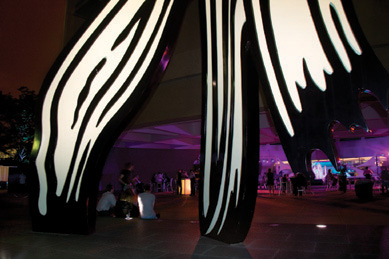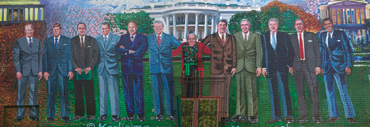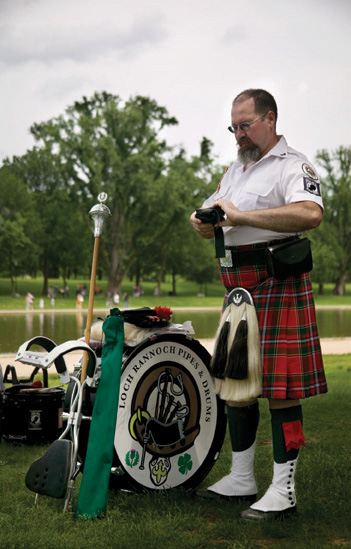
Irish drummer preparing for a performance on the National Mall.
Washington, DC is a dynamic metropolitan region of more than five million residents. Add to that the estimated 15 million visitors annually, and you will recognize how it is that people breathe life into this elegant city. If the essence of a city can be defined by its people, then Washington, DC represents a complex fragrance with multiple notes and undertones.
The international and sophisticated temperament of the people of the city is vividly reflected in its wide array of restaurant cuisines, customs of dress, food markets, cultural venues, and the languages heard every day on the streets and sidewalks.
Adding to the distinctiveness of DC is its role as the nation’s capital. Government and patriotism overlay the city. Nearly every vista will include the waving Stars and Stripes, a serviceman, or the purposeful stride of a suited policymaker. This chapter offers the insider information required to observe and capture images of the people who constitute this multifaceted metropolis and the photographic still lifes that they continually create.
Travel photos that focus on indigenous people juxtaposed with details from the world they inhabit are, in my mind, the most successful and will elicit oohs and aahs from family and friends. Try to get in the habit of being aware of all of your senses when you are photographing. Think about blaring car horns, the drum beat of music, or pungent homemade cheese and fresh-from-the-vine tomatoes, and put the appreciation of these experiences into your photographs. Photography is not only about seeing, but it is about storytelling and evoking an emotional response from your viewer. An attention to sensory detail will become, with practice, a palpable force in your pictures. Exercise your personal aesthetic, and your photographs will stand out from the crowd’s.
My most oft-used lens when I am trying to capture the essence of a place is a 28mm–135mm zoom lens. A zoom lens like this obviously allows you the convenience of many focal lengths within one lens. You are able to shoot in a variety of situations without having to take the time to switch lenses, at the risk of losing a fleeting or time-sensitive photo opportunity. The telephoto end of the focal length allows you to really home in on what you are photographing and makes it a little simpler to capture intimate details. An aspect of the longer focal lengths that I am particularly drawn to when shooting these close details is the shallow depth of field that occurs if you shoot with a wide aperture. The backgrounds become beautifully soft and out of focus, which makes them less distracting, letting the eye really focus on the chosen subject matter. The 70mm–85mm range is perfect for portraits—you can be close enough to your subject to still communicate easily, but the subject will be separated from the background.
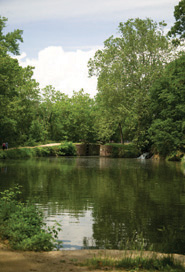
A view of the tranquil canal.

Youngsters fishing at a park outside Washington, DC.
The wide angle end of the zoom lens is perfect for including more of the surrounding environment in your photograph. These wider point-of-view shots, when combined with your detail photographs in a display of “city life” mementos, will tell a well-rounded and all-encompassing story of your vacation experience.
More so than many types of photography, shooting people and their surroundings requires that you, to some extent, be a little adventurous and polish your interpersonal skills. You don’t want to be solely a voyeur—making a positive connection with your subjects is the first step in taking good people pictures. To that end, do your best before you set out to prepare for that good impression. Make sure you are not wearing that old and tattered college T-shirt plastered with the offensive slogan you were so fond of. Dress in a relatively neutral and clean manner, and it will be your subjects who are at center stage, and not you.
Be open, honest, and friendly. I am constantly amazed at how many doors one can open if you assess the situation and your potential model’s personality quickly and sensitively, without being smarmy or overly intrusive. It does take a little practice, but you will find that if you adopt a forthright and slightly curious manner when asking to take someone’s photograph, you will hear yes a lot more than no. You might let them know why it is that they caught your eye and perhaps communicate that you are an artist who enjoys photographing people. Most folks are actually flattered when asked to be photographed, and I guarantee that you will make some friends in the process. If your subject does decline your request for a photo, respect his or her wishes, be deferential, and move on to the next opportunity.
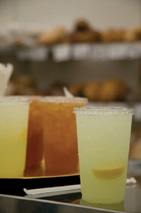
A close-up of fresh tea and lemonade.
The most important quality to possess in this situation, however, is a razor-sharp awareness. Expressions, gestures, and situations can be incredibly fleeting, and you don’t want to miss a trick. When you come upon a place that you sense has some photo opportunities awaiting you, put your sight and hearing into overdrive, and if there are people and moving things involved, once you have garnered permission, start shooting as soon as you can. The most photogenic mannerisms are often the earliest and least self-conscious on the part of the model. If you are shooting still lifes or details of a scene, be very inquisitive, explore many angles and views, and give yourself time to make an appealing composition. An unexpected point of view can often be the most visually arresting for a photograph.
Note
Make sure all your gear is in working order (cards loaded, batteries charged, filters on) and that your settings are correct before you reach your location and start to shoot. There is nothing as maddening as finding yourself in the heat of the moment with a dead battery or a full memory card. Your model will also appreciate your preparedness.
This vibrant district in northwest DC has a character that derives from a fluid diversity of influences. For many years, the area and its typical row house architecture offered a first home to many Central American immigrants, followed in later years by Africans, Asians, and arrivals from the Caribbean. More recently, the district has seen significant gentrification, and price escalation has displaced many of the earlier residents. What persists, however, is an area still known as the heart of the Latino community but famous for its nightlife of bars and restaurants, all with a little boisterousness thrown in!
The district took on its current shape in the 1950s, when a redistricting program combined portions of surrounding areas to create the current community. The diversity of the district is reflected in its name, which derives from that same time, when the previously all-white John Quincy Adams and the all-black Thomas P. Morgan elementary schools were desegregated and gave their names to the current district.
The neighborhood reserves the second Sunday in September for the Adams Morgan Day Festival and presents a full-on celebration of its diverse and lively culture. However, for the remainder of the year, the thriving five-square-block area offers more than a dozen different ethnic cuisines and intriguing international shopping. At night, many of the bars and clubs feature live music—a magnet for the young professionals of DC.
In the evening and into the wee hours of the morning, the spotlights and fluorescent signs of the restaurants and clubs in Adams Morgan make a flamboyant and colorful display. The façade of this Falafel Shop was an easy target, as the vivid crimson and bright white contrast beautifully with the emerald green leaves of the gingko tree in the foreground and make a strong, graphic photograph. The hustle and bustle of tourists and club-goers perfectly disguised my camera, tripod, and me, and aside from the occasional catcall of “nice lens,” we were relatively ignored. I used my tripod and a cable release to prevent camera shake at this longer exposure, and my on-camera flash was set to expose the foreground leaves at a stop under my overall exposure. Do remember to keep an eye out for your equipment during nighttime shoots, however, as not all crowds can be so benevolent.

Focal length 53mm; ISO 100; aperture f/5.6; shutter speed 4/10 second; April 8:29 p.m.
People are not always your only live and willing subjects for street portraits. This furry fellow is a regular and alert sentry at the window of this Adams Morgan apartment, and his gaze is deeper and more piercing than that of many humans I have photographed!
With animal portraits, it is crucial to either grab the sitter’s attention and keep it focused on the camera or capture the animal in an anthropomorphic gesture as it wiggles and squirms. It is the very humanness of this dog’s stare, body position, and task that make this photograph interesting. My tactic for capturing a charismatic expression from this mastiff was to watch and wait—he was very busy at his post, and he constantly looked and barked this way and that. My patience paid off, however, and after a few minutes he turned and gave me his best guardian glare.
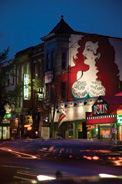
The Adams Morgan main drag at early evening.
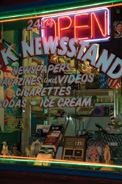
The window of an international newsstand.
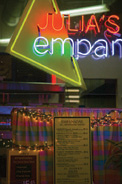
A colorfully lit window at an empanada café.
Parking is limited in the Adams Morgan district, and the Metro offers the best approach. The district is equidistant from four Metro stations. An approximately half-mile walk from the Red Line stations Woodley Park and Dupont Circle or the Green Line stations U Street/Cardozo and Columbia Heights will find you in the Adams Morgan section of town:
Woodley Park Station: Walk 150 yards south on Connecticut Avenue and turn left on Calvert Street. When you reach Columbia Road, the Adams Morgan area will be ahead of you.
Dupont Circle Station: Go north on Connecticut Avenue, and after 500 yards, turn right on Florida Avenue. Turn left onto 18th Street to enter the district.
U Street/Cardozo Station: Follow U Street west for 800 yards and turn right onto 18th Street.
Columbia Heights Station: Follow Columbia Road west/southwest for 800 yards and turn left onto 18th Street.
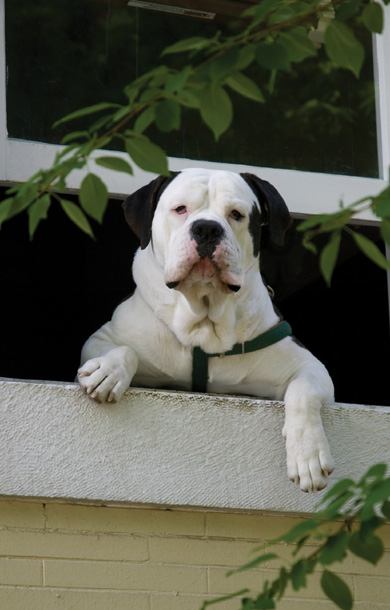
Focal length 105mm; ISO 100; aperture f/5.6; shutter speed 1/60; April 7:56 a.m.
A regular Saturday morning, a casual bike ride into the center of DC. Even on the weekend, the city bustles. It seems to own a powerful heartbeat. Wait a minute—it does have a heartbeat! Follow the pulsing sounds of the drumming rhythm to its source, and you’ll discover Batala!
In Farragut Square, on Saturdays between 10 and 1 o’clock, you will find Batala, the all-women, Afro-Brazilian percussion band, perfecting their driving and enthralling rhythms in readiness for another of their acclaimed public performances. Batala Washington is the newest branch of a global family of samba-reggae percussion bands with sister bands in France, Belgium, England, and of course Brazil, from where the musical style originates. The band entertains at festivals, parades, and sports events throughout the city.
You will find that the visual images presented by this group of strong and independent women match their music in its power and captivating attraction.
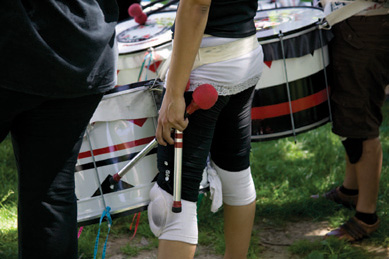
A moment of rare quietude.
Note
Want more exciting images? Exercise your design sense and play with unusual combinations of color and contrast.
The heat is most definitely turned up when Batala performs at a public event, and the energy is intoxicating. As usual, at this shooting session, I heard Batala long before I saw them. In fact, the marching band I was actually taking photos of were so hypnotized by the drums and swaying bodies that they discarded their own sound and began to dance to the beat of Batala! To catch the women with a relatively crowd-free background (which is difficult—once they start walloping those drums, the hordes magically appear), I went to the staging area of this parade at Madison Drive NW between 4th and 7th Streets, about two hours before starting time. This gives you plenty of room to roam and find the best vantage point for a frame that is dynamically filled with their moving bodies. Listen to the beat, make sure your shutter speed is relatively short to capture the movement, and for the most energetic shot, press the shutter on the upswing of their sticks.
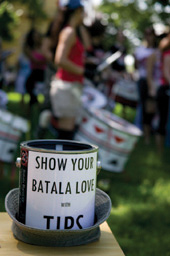
Show your appreciation.
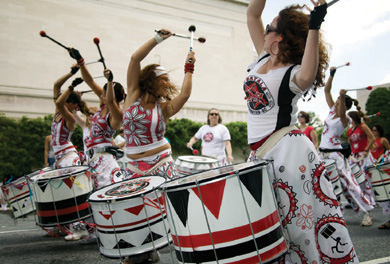
Focal length 47mm; ISO 100; aperture f/4.5; shutter speed 1/200; April 10:27 a.m.
All that drumming, and these ladies get tired! A photo collection comprising only energetic shots would be powerful, but nowhere near as compelling as a series of pictures that tell the whole story of what actually goes into these performances and what happens behind the scenes. Keep your eyes open for details that give background information, and your viewers will be more captivated. I caught this shot of a dozing drummer during a break in a practice session one morning. She was so tuckered out that I had gobs of time to move around and compose her just as I wanted amongst the resting before she awoke, at which point we flashed big smiles at each other and had a good laugh.
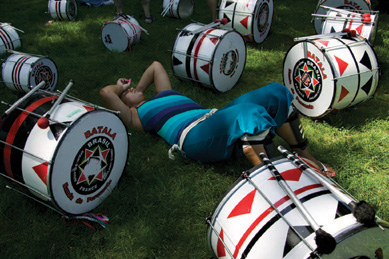
Focal length 33mm; ISO 100; aperture f/5.6; shutter speed 1/200; May 10:05 a.m.
Farragut Square is located at the intersection of K and 17th Streets. The Square is served by its own Metro station—Farragut North on the Red Line.
The Batala website, www.batalawashington.com, has a schedule of practice sessions and events to allow you to use more than just your own sense of hearing to find them.
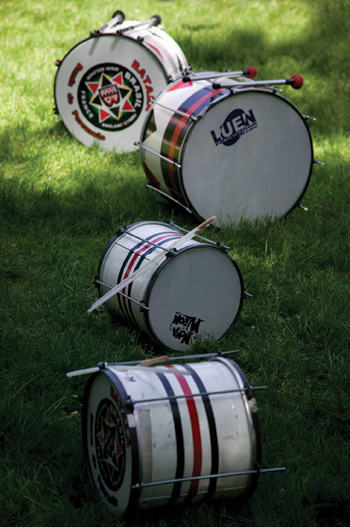
Tools of the trade.
The Chinatown area in DC, situated to the east of downtown, may be considered more of a three-course lunchtime special than a ten-course banquet. In the 1930s, the original Chinatown section of the city, to the north of the Mall, was replaced by the Federal Triangle complex, and residents of Chinese extraction congregated in the current area, setting up homes and thriving businesses, covering a dozen city blocks. Since its heyday, under pressure from urban flight, gentrification, and development of the valuable local real estate—for example, by the Verizon Center sports and entertainment complex—the community has shrunk in its scale, but what remains shows the distinct character of Chinese-American industry and culture.
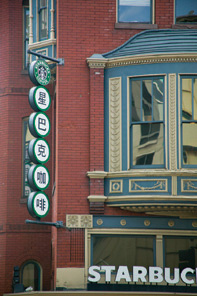
Chinese characters grace a familiar storefront.
Taking pride of place, and powerful in its imagery, is the 60-foot Friendship Archway, a striking span reaching across H Street and signifying ties between DC and its sister city, Beijing. The dozen or so photogenic Chinese restaurants drive this sense of Chinese flavor as you pass through the streets. It is customary for much of the storefront signage to use both English and Chinese characters, and even on the multiple instances of the stores of national retail chains, you will find Chinese versions of familiar logos. On the appropriate date in late January or early February, the area hosts the Chinese New Year Parade. Chinatown bursts into life through a kaleidoscopic concoction of dragons and firecrackers, marchers and bands.
This chef and her “office” are on display to all who stroll along 5th Street NW in Chinatown. Day in and day out, she plies the soft dough into swirled and tasty little noodle pillows, and it is a sensory delight to watch her wield her rolling pin amidst clouds of flour. One of the oddest impressions is the contrast of the boisterous and chaotic sidewalk to her absolutely silent machinations behind the thick glass window. She is no stranger, I am sure, to the lens, and she generously offers a knowing and omniscient mien. I found her to be an obliging model as I photographed her from many angles, and she was always there, working with the camera. My polarizing filter was indispensable in this situation, as reflections of the street in the window would have been extremely distracting without it.
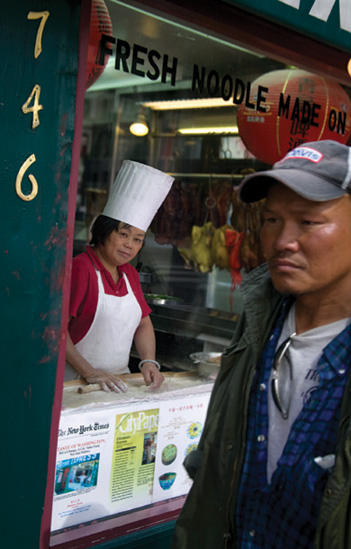
Focal length 50mm; ISO 100; aperture f/4.5; shutter speed 1/100; May 2:57 p.m.
This beautiful Chinese-influenced building façade can be found on H Street NW, the main drag of Chinatown, near the corner of 6th Street NW. The proportional arrangement of the windows and the colorful combination of red, green, and cream literally beg to be recorded. The off-balance addition of only one upright lamp is a nice asymmetric touch to a picture that otherwise could be quite dull in its perfect geometry. I used a short telephoto lens length to keep the angles straight and stood on a low wall across the street, so that my camera was at the same level as the lower rooftop. In this type of photograph, it is crucial that you avoid converging lines, which would ruin the graphic quality of repetitive shapes.
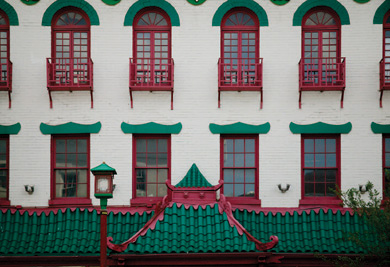
Focal length 85mm; ISO 100; aperture f/5.6; shutter speed 1/250; May 2:46 p.m.
Note
If faced with telephone wires and streetlamps that can be unavoidable when shooting a street scene, try zooming in and making a tight, graphic composition. This can be a great way to salvage an otherwise unattractive photograph.
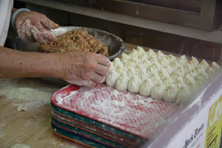
A close up of dumplings.
Chinatown is located east of downtown Washington between H and I Streets NW and 5th and 8th Streets NW. The Gallery Place/Chinatown Metro Station (Red, Yellow, and Green Lines) is sited on H Street and allows you to emerge directly onto the southern side of Chinatown. The Friendship Archway spans H Street by 7th Street.
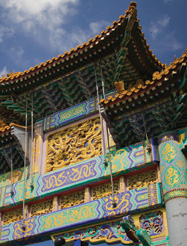
A close-up of the Friendship Archway.
The grandeur of downtown Washington, DC has been developing for more than two centuries; that development has consisted of dramatic national and governmental structures contrasted by modern commercial buildings. This process continues as the downtown area pushes outwards into the District as a whole and can be observed in the area around the intersection of 7th and M Streets. To the north and east of this point lie older row homes and small businesses; to the south and west lie modern commercial structures. The Walter E. Washington Convention Center (opened in 2003 and named after the District’s first home rule mayor) stands at the edge of redevelopment, constituting one further, large step in the outward expansion of the downtown area. This area of transformation provides superbly contrasting architecture and opportunities for varied subjects.
Serendipity and a perceptive eye will bring home photographs of delightful scenes such as this. One morning during cherry blossom season, this tableau greeted me immediately as I emerged from the DC Guesthouse, a B&B in the neighborhood. The crystalline aspect of the light, the appearance of snowfall in April, and the odd composition of car and tree are what drew me to make a picture. I am particularly keen on the way in which the long diagonal shadows cast on the building across the street, combined with the light dusting of petals on the car and the tree trunk, trick the eye into seeing the movement of actual snow falling. As I do with most still life shots, I recorded several frames, changing my composition and framing slightly so that I could choose the most appealing one when editing at home. But, I must admit, what happened here—and what does happen about 90 percent of the time—is that the initial view was the best.
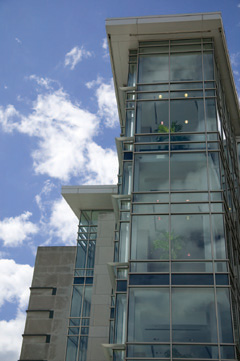
View of the new Convention Center.
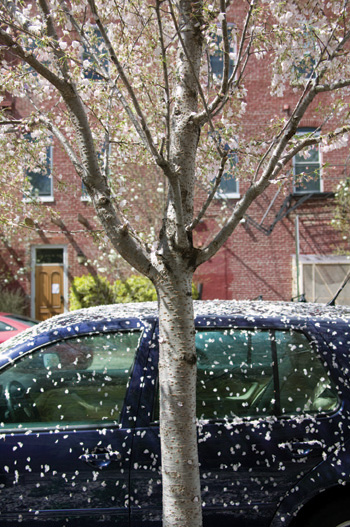
Focal length 44mm; ISO 100; aperture f/5.6; shutter speed 1/200; April 11:46 a.m.
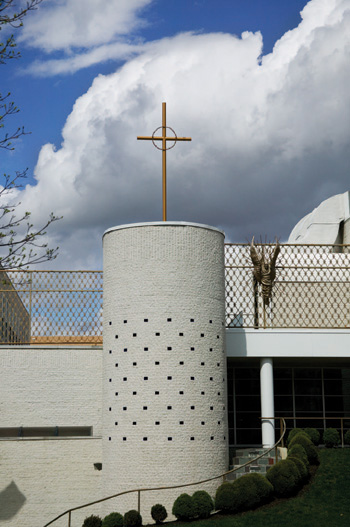
Focal length 70mm; ISO 100; aperture f/7.1; shutter speed 1/1600; April 1:12 p.m.
The United House of Prayer for All People on M Street is a striking building, and the thunderous clouds, strong sun, and intense blue sky in this photo only exaggerate its odd, yet powerful appearance. Drama is the overriding theme, and one can almost hear the resounding boom of the preacher and the boisterous, appreciative reverence of the congregation. Lucky timing came into play again—the curve of the clouds almost perfectly mirrors the curve of the brass railing and repetitive line of the bushes. I stood across the street from the church, at the top of the entrance stairs to a residential brown-stone. This slightly elevated stance kept the parallel lines of the turret from converging, which would have marred the strong geometry of the photograph.
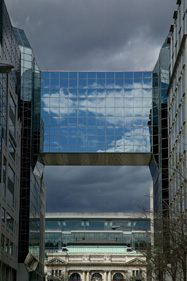
The Convention Center and the Historical Society, juxtaposed.
Historically, farmers would find an outlet for their produce at the local market, perhaps spending a day hauling their goods to the nearest town in the hope of finding enthusiastic customers for their fresh wares. In time, with the advent of efficient transportation, most produce was shipped into all-embracing distribution chains and could appear for sale throughout the country. A few farmers, perhaps, continued to sell at least some of their goods at the farm gate or on a busy road close to the farm. With the emergence of food trends in which consumers have developed a keener interest in the providence of their food, its freshness, and the impact of its production on the environment, farmers’ markets across the country have emerged as an opportunity for farmers to once again sell locally. Washington, DC is no exception, and many markets can be found throughout the region. Within these markets you will see fine, and often exotic, produce displayed against interesting and fluid backdrops. Farmers’ markets: an opportunity for farmers and consumers, but also for photographers.
A farmers’ market is a feast for every appetite. No matter what the season, the stalls are brimming with colorful produce and locally manufactured goods, and during springtime, the bounty of flowers is almost overwhelming. At the Eastern Market, I was drawn to a stall filled with red and pink dianthus, a relative of the carnation. The diffused light created by the white tent cover makes a beautiful situation in which to photograph and mimics the light that pro studio photographers covet. Into my field of view strolled a mother and a little girl with a pink balloon, both wearing magenta dresses. I felt for a moment that there was a set stylist nearby, putting all the pieces of my shot together! When you spy moments such as these, you must act quickly. Children do not stand still for long. Again, a reminder to have your camera prepped and ready to shoot, with spare batteries and memory cards at hand. This way, shots such as these will be yours to grab.
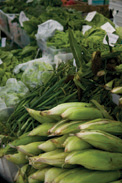
A tableau of green vegetables.
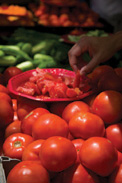
The temptation of fresh tomatoes is not to be ignored.
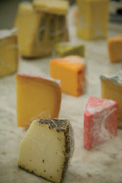
Fresh cheese at the interior of the Eastern Market.
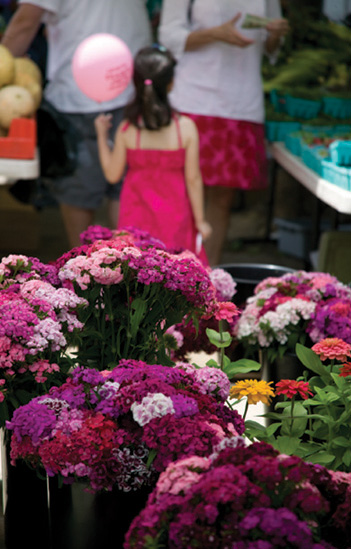
Focal length 135mm; ISO 100; aperture f/5.6; shutter speed 1/200; May 12:11 p.m.
In addition to fostering vegetable voyeurism, farmers’ markets are also a perfect opportunity for people watching. I find that shoppers are so engrossed in their own activities and so food-focused that they really don’t notice me or feel self-conscious of the camera. This shot was taken inside the food hall at the Eastern Market, which, like the stalls outside, has an enormous translucent white roof, filling the space with lovely soft, bright light for shooting. This group of three in their matching white T-shirts made an attractive and monochromatic composition with the black-and-white chalkboard above and the graphic shapes of the stools and legs below. Notice that I followed the Rule of Thirds here, with areas of black sandwiching a strip of white in the middle.
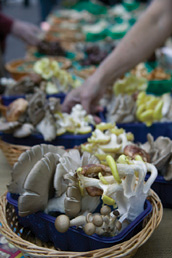
A variety of mushrooms at a market on E Street NW.
Judicious use of the Internet will quickly give you the location and timing of more than a hundred farmers’ markets within the Greater Washington region.
Some of the photos in this section were taken at the Penn Quarter Farmers’ Market, located at the north end of 8th Street between D and E Streets NW. Markets have stood on this spot for more than 100 years. From the Archives Metro Station (Yellow or Green Line), walk north on 7th Street for one block and then turn left on D Street. The market will be on your right, one block farther. The market is open on Thursdays from 3:00 to 7:00 p.m.
The other shots were taken in the Farmers’ Market section of the Eastern Market. The Eastern Market is located at the intersection of C Street SE and 7th Street SE. Exit at the Eastern Market Metro stop (Orange and Blue Lines) and walk one and a half blocks north on 7th Street. The farmers’ produce is displayed on Saturdays and Sundays from 7:00 a.m. to 4:00 p.m.
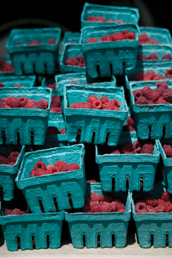
A stack of fresh-picked raspberries at the Eastern Market.
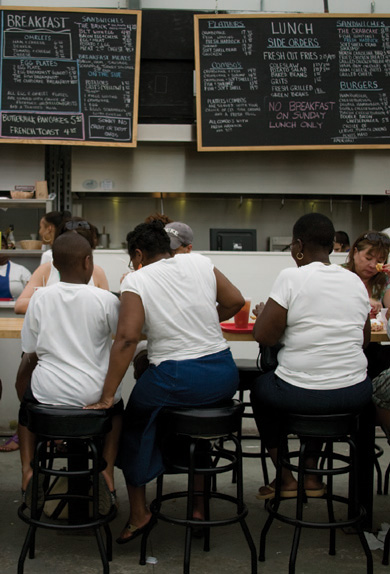
Focal length 30mm; ISO 100; aperture f/3.5; shutter speed 1/160; May 12:58 p.m.
If you are looking for a change of pace from DC’s grand sights, make your way to the Washington Fish Market—or, as it is also known, “The Wharf.” Here you will find a briny slice of life and meet many local Washingtonians relishing their purchases of raw fish or fish-restaurant offerings.
The market has the air of a well-kept but elderly nautical theme park, with the bright and colorful shop fronts competing with the equally showy displays of fish and shellfish. The fishmongers themselves complement the displays and take very little persuasion to pose with their wares. At many of the stalls, you can purchase ready-to-eat foods, and the lines for these treats attest to the quality and freshness of the food. Jimmy’s, beside the entrance to the Market, is famous for its crab cakes and also does a mean sideline in desserts.
The Market is open daily, but on weekends the displays are at their finest.
This salty dog of a fellow gets the blue ribbon for being one of my most willing and enthusiastic photo subjects ever! He morphed into his pose with such ease that I know he has done this before—especially when he asked me if I worked for the Discovery Channel! The Fish Market, much like the Eastern Market, boasts a beautiful and diffused lighting scenario that wraps your subject with soft light and shadows, which was flattering to both the gentleman and his colorful wares. I filled the bottom of the frame with the abundant display of crabs, which lends this image texture and a beautiful range of natural colors. Notice, also, the multiple touches of bright blue that take your eye around the photo—the hundreds of crabs’ legs, the seller’s T-shirt, his eyes, the sign behind him, and last but certainly not least, the pen behind his ear! After your shoot, a fresh seafood lunch beckons you!
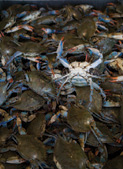
Edge to edge blue crabs.
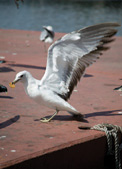
Another type of patron enjoying his free lunch.
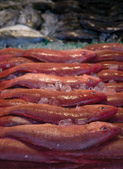
A tidy arrangement of red snapper.
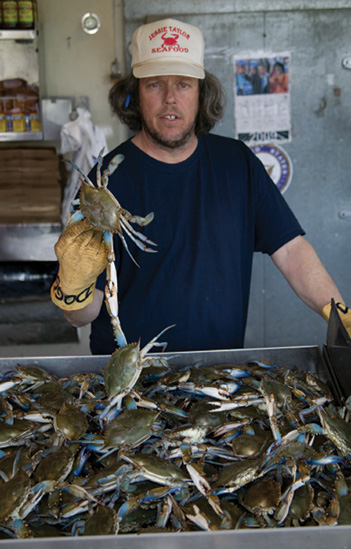
Focal length 60mm; ISO 100; aperture f/5.0; shutter speed 1/80; April 11:02 a.m.
If gaping mouths, exposed flesh, and shiny silver skin are your game, then you will be right at home at the Fish Market! This scene is at the left-hand side of the U as you enter the wharf, and it is the main fish sales area. I really wanted this picture to communicate the overwhelming abundance of seafood, so I placed the camera lens just on the edge of the display. To do this, I had to step off the sidewalk and actually down into the stall, which is no problem with the vendors. They are friendly and do not mind in the least. Compose your frame so that the signs butt up against the left edge of your frame, and try to maintain a bit of space on the right to include a touch of humanity in the form of a paying customer.
Although perched on the bank of the Washington Channel of the Potomac and adjacent to the Jefferson Memorial, the Washington Fish Market is not the most easily found of sights. It is located off Maine Avenue where the I-395 Freeway crosses overhead. The most straightforward approach, using the Metro, is to go to the Smithsonian station on the Orange and Blue Lines and then walk half a mile south on 12th Street to the intersection with Maine Avenue. You should be able to see Captain White’s sign ahead of you below the overpass. Alternatively, you can find your way from the Tidal Basin and/or Jefferson Memorial using trails and sidewalks to get onto Maine Avenue and then to the Market.
The Market does feature free parking, and this may be one Washington visit for which using your car may be a good bet…especially if you end up with a fishy purchase to carry away.
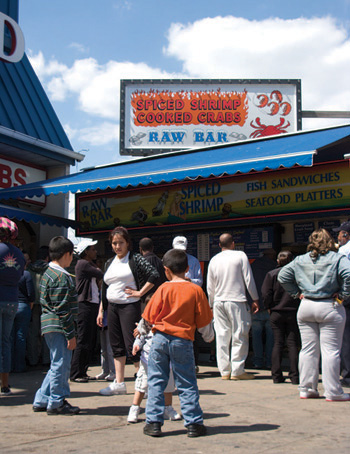
A view of the busy raw bar.
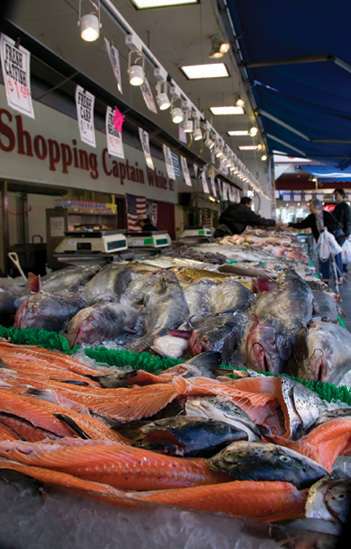
Focal length 28mm; ISO 100; aperture f/8; shutter speed 1/4; April 10:41 a.m.
And before there was Washington, DC, there was Georgetown. Established in 1751, when the Maryland Legislature purchased 60 acres of land bordering the Potomac River for 280 pounds sterling, the town was named after the monarch of the time, George II. (Patriots may prefer the alternative explanation that the previous owners were both named George and passed their name on to the town.) Georgetown represented the highest navigable point on the Potomac and developed as a valuable port. Remnants of canals used in the distribution of goods dissect the town.
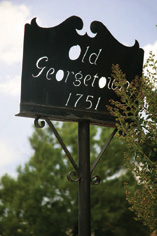
The sign at the eastern edge of Georgetown, at Pennsylvania and M Streets.
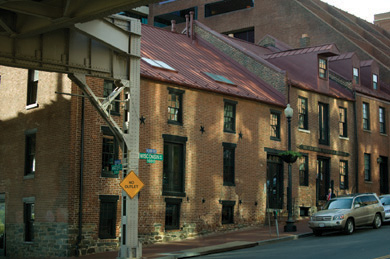
A scene with old and new next to the riverfront park.
When the plans for DC were drawn up, Georgetown was included as an integral district, and in the early days of the capital, the previously established town was the cultural center of the city. It retained its technical independence as a municipality until 1871, when it was completely assimilated. The cultural status of the town has waxed and waned throughout intervening years with the development of other parts of DC. At the present time, Georgetown, while retaining the major part of its older character, has experienced tremendous gentrification and is a much sought after business address and residential area.
Within the town limits, you will now find high-end shops, bars, and restaurants offset by upscale condominiums and offices. On the quieter streets, attractive, historical architecture abounds, constituting the major part of the housing stock. Bordered to the south by the Potomac, Georgetown features a new waterfront park in which to relax and enjoy the splendor of the river.
The small side streets and alleyways of Old Georgetown near 28th and 29th Streets NW are a treasure trove of architectural gems, and ivy and old brickwork abound. This particular home caught my eye, as one side literally seemed to be a mirror image of the other. Aside from rush hour, the streets are quite free of traffic, and it is easy and safe to stand in front of the homes and compose your photographs in a relaxed fashion. The impact of this type of picture is crucially dependent on accurate composition, so do use your tripod, if you have it, to ensure that the lines of the fence and walls are horizontal and that your framing from left to right is symmetric and centered.
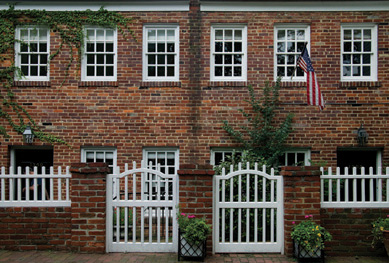
Focal length 44mm; ISO 200; aperture f/5.6; shutter speed 1/200; July 3:15 p.m.
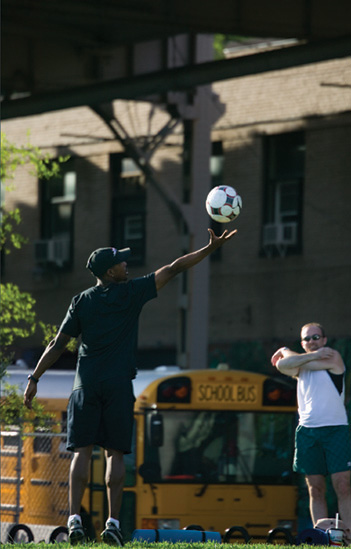
Focal length 300mm; ISO 100; aperture f/6.6; shutter speed 1/60; April 5:13 p.m.
This adroit athlete was teaching a phys-ed class in the park on the waterfront promenade. His energy was frenetic, and I think he must toss that soccer ball in his sleep! I used my 300mm lens both to stay out of his way and to take advantage of the short depth of field, which, along with the nice edge light from the setting sun, separates the subject from the background. I was careful to place him so that it seemed as if he was stretching up from the edge of the frame and to surround him with the urban architecture of the bridge. I also am glad I caught the approving smile from his student.
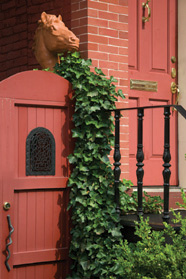
An equestrian-themed entryway.
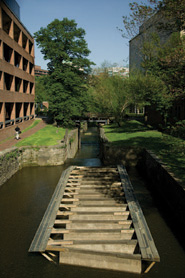
The canal in Old Georgetown.
Georgetown is located to the west of the central part of DC. The town clusters around the intersection of M Street and Wisconsin Avenue. It is not well served by the Metro system, but if you do take the Metro to Foggy Bottom on the Orange or Blue Line, a Route 31: Wisconsin Avenue Line Metrobus will take you the three-quarters of a mile along Pennsylvania Avenue and M Street to the center of Georgetown. Alternatively, take the Georgetown Metro Connection bus from Dupont Circle; this leaves every 10 minutes and shuttles between Dupont Circle and Rosslyn Metro stations via Georgetown.
The Smithsonian Institution may be one of the world’s most prestigious complexes of museums, galleries, and research institutes, but to this day its founding origin is cloaked in mystery. The Institution comprises 19 museums, 165 affiliate museums, 9 research centers dispersed around the globe, and the National Zoo. All told, the Institution owns more than 136 million specimens and holds a place of high esteem in the academic world. Smithsonian establishments are located throughout DC.
When James Smithson, an accomplished British scientist, died in 1829, he left his substantial estate to his nephew. However, he stipulated that were his nephew to die without heir, the entire estate would pass to the people of the United States of America, “to found at Washington, under the name of the Smithsonian Institution, an Establishment for the increase and diffusion of knowledge….” The nephew did indeed die without heir, and the bequest, valued at more than $500,000, was, after much administrative debate, accepted by Congress. The Institution was formed in 1846. The motivation behind this bequest remains unclear, particularly since Smithson had never traveled to the U.S. and had no known correspondence with Americans. Speculation indicates that Smithson was unhappy with British society, given his treatment as an illegitimate son of gentry, and viewed the fledgling republic across the Atlantic as a more worthy recipient of his fortune.
The first Smithsonian building, located on the National Mall and popularly known as the Castle, was completed in 1855. It is aptly named given the crenellated Norman architectural style and the red sandstone building material. Remodeling in 1968–69 emphasized the Victorian character of the internal and external aspects. The Castle houses the Smithsonian Information Center, which serves as the focal point for information about the Institution’s 17 museums and the National Zoo in Washington, DC and the two museums in New York City.
Nighttime shooting is extremely gratifying for a number of reasons. It is quite a treat to roam the empty streets and sidewalks, and with the dearth of tourists and townspeople, many photographs are within your grasp that during the day would be next to impossible. And with the ability to use long shutter speeds, the elements of movement and motion blur can be added to your creative repertoire. What I reap the most pleasure from, however, is the unpredictable color palette that occurs as a result of the unusual and varying color temperatures of the after-hours illumination. It is this element of the unexpected that makes shooting in low light so interesting, and that is what I experienced at the flower garden of the Smithsonian Castle. The misty night sky turned mauve at the 10-second exposure, and the light from the sodium vapor streetlamps gives the scene an eerie, chartreuse glow. The long exposure turned the surface of the fountain into a soft mirror, and the flowers, nudged by a gentle breeze, are nicely blurred. Use of your tripod is critical here, and the cable release helps to avoid any camera movement.
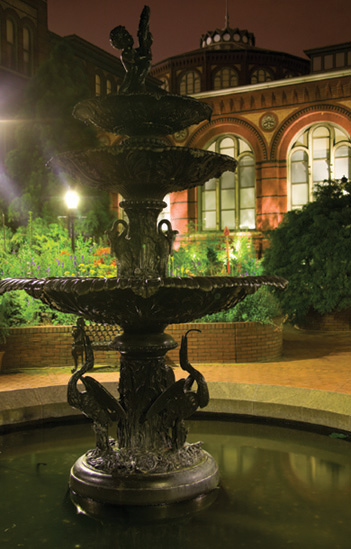
Focal length 44mm; ISO 100; aperture f/4.5; shutter speed 10 seconds; June 10:55 p.m.

The petrified wood display.
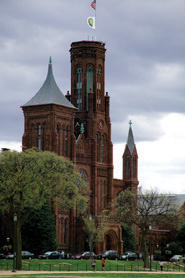
Another view of the Castle.
The Castle is Gothic and romantic, and it makes a theatrical photograph from almost any angle, but in spring, with the leafless branches framing and tracing the scene, you are guaranteed some extra drama. The warm, late-afternoon sun beautifully puts the brickwork into high relief, and the grandeur of the towers is in striking contrast to the seemingly minute walkers and runners on the Mall below. I shot from across the Mall, directly northwest from the entrance to the Castle. Be sure to keep your camera parallel to the ground— the pale line of the sidewalk will help you with this aspect.

Focal length 100mm; ISO 100; aperture f/10; shutter speed 1/200; April 4:57 p.m.
The Smithsonian Castle is located at 1000 Jefferson Drive, which passes east-west through the National Mall. It lies a third of a mile to the east of the Washington Monument. The Orange and Blue Metro Lines will take you to Smithsonian Station. From there, walk north into the Mall on 12th Street and turn right on Jefferson Drive. The Castle will be on your right.
How does a nation’s flag come into being? Looking closely at the advent and evolution of the national flag of the United States of America, you will see reflected stages of development of the nation itself. When the original 13 colonies were operating essentially as a group of businesses under the auspices of the British East India Company, they rallied around the company flag. This contained the version of the British flag in use at that time positioned in the upper-left corner of the flag. The remainder of the flag consisted of 13 stripes representing each of the colonies. In the minds of the colonists, the flag transitioned from the banner of a company to a symbol of the developing nation.
With the achievement of independence, the top-left corner (union) of the flag was replaced. The Second Continental Congress at Philadelphia on June 14, 1777, “resolved, that the flag of the United States be thirteen stripes, alternate red and white; that the union be thirteen stars, white in a blue field representing a new constellation.” This description lacked specificity and left room for interpretation, particularly of the placement of the stars.
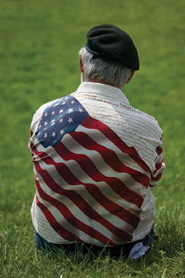
A patriotic by-sitter.
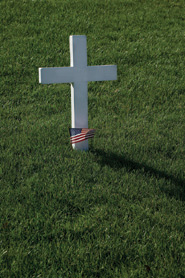
A simple cross and flag at Arlington National Cemetery.
The Betsy Ross design (of which Betsy’s input is uncertain) with 13 stars in a circle is one of the versions from that time. With the country’s growth through the addition of new states, the flag was updated, 26 times to date. The inclusion of Alaska and Hawaii in 1959 led to the addition of the 49th and 50th stars, giving the nation its current flag. Provisional designs have been prepared for the addition of further stars—perhaps those who have referred to Britain as the “51st state” know something.
And how should a nation treat its flag? Much loved, often affectionately referred to as the Stars and Stripes, the Star Spangled Banner, or Old Glory, the flag elicits a strong emotional response. U.S. Federal law defines appropriate use of the flag in the Flag Code. Among other things, this bars use for advertising purposes and also use “on such articles as handkerchiefs, napkins, boxes or anything intended to be discarded after temporary use.” You may consider from your experience how well this code is policed. Indeed, the Supreme Court has supported arguments that the right of freedom of speech can override elements of the Flag Code. Despite the ebb and flow of such debate, the Stars and Stripes remains to most Americans the beloved symbol of the nation and is displayed and worn with pride in a multitude of ways.
What a perfect way to avoid the harsh and high-contrast shadows of midday—shoot underneath a flag, and an enormous one at that! It was the red, white, and blue glow on the asphalt that caused me to point my camera in the direction of this scene, and I am still transfixed by the striped and starred shadows that are evident. I also enjoy the “photo within a photo,” as the image of the flag on the road could, in some senses, be construed as a “photograph.” It is “drawing with light,” after all, which is what the word “photography” derives from. The wide angle of my lens captures the vast expanse of the flag, and the fast shutter speed keeps the flapping fabric crisp and sharp.
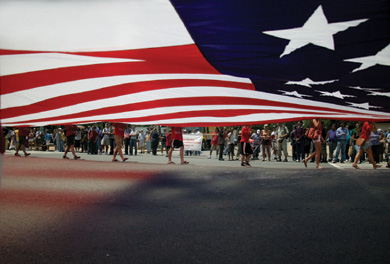
Focal length 28mm; ISO 100; aperture f/4; shutter speed 1/1250; July 12:08 p.m.
Another playful use of light is the reflection in this motorcycle helmet. The convex shape gives you almost a 180-degree view, and of course, I am visible also. The gray of the overcast sky maintained the “silver” tone of the metal—this shot would have looked very different and not as effective if the sky had been a cloudless blue. The saturated colors of the flag are in stark contrast to the black leather and silver chrome of the motorbikes, and I like the fact that the flag is almost the only spot of color in an otherwise duotone background. My choice of a wide aperture, and thus a shallow depth of field, maintains focus only on the flag, keeping it again as the focal point of the shot.
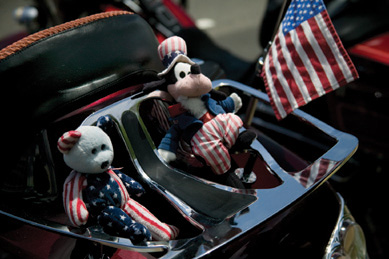
A bit of humor lightens the patriotic touch.
Imaginative and creative, casual and formal, but almost universally patriotic portrayals of the Stars and Stripes can be found throughout the District. Keep your eyes open around the National Mall, which attracts many Americans keen to display their colors.
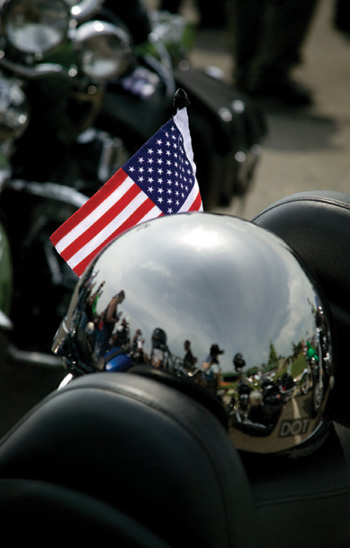
Focal length 125mm; ISO 100; aperture f/5.6; shutter speed 1/400; May 9:50 a.m.
Woodley Park is a charming neighborhood of historical residences and a wide diversity of restaurants. It is intersected by Connecticut Avenue and sits between the National Cathedral to the west and the National Zoo to the east. Indeed, it might easily be overlooked in the shadows of these popular DC destinations. However, stop and take a look. See how many of the residents of this leafy suburb have embellished their fine early twentieth-century homes by adding subtle color and design twists to generate an elegant and attractive environment. In addition, observe how many owners have expanded the envelope of home decoration while boldly reflecting their partisan views in this most political of cities.
The origins of the symbols of the country’s two main political parties—the elephant and the donkey—are seated in the nineteenth century. Neither was created by a high-priced PR company nor benefited from a splashy launch. Rather, they both came into being through the medium of the political cartoon and gradual adoption.
In 1828, while running for the presidency, Andrew Jackson was labeled a “jackass” by his opponents. In the time-honored tradition of politicians turning a negative into a positive, Jackson adopted the donkey as a symbol, emphasizing his characteristics of stubbornness and commitment. In 1837, the donkey was again used in a derogatory manner, but this time in a cartoon referring to the Democratic Party as a whole.
In 1870, Thomas Nast, contributing in Harper’s Weekly, cemented the donkey’s role as party icon by repeatedly using it in his cartoons. Nast is also credited with entrenching the elephant as the symbol of the Republican Party. In 1874, building on two earlier cartoons, he used a cartoon elephant, headed toward a tar pit of inflation and chaos, to represent the Republican vote and its interest in supporting Ulysses S. Grant in running for a third term.
The party symbols in their own way represent the nature of much political debate. Both parties see the noble qualities of their adopted beast while deriding the character of the other party through the negative attributes of its chosen symbol. However, through witty and creative use of the icons, the people of Woodley Park have made a fine effort at enlightening and entertaining neighbors and visitors alike.
These figures of the donkey and the elephant grace the expansive front lawn of the Swiss Chancery at 2900 Cathedral Avenue. Since 9/11, massive fences unfortunately have sprouted up in front of many international properties, and this one is no exception. As a result of this obstruction, there is no spot to stand with your camera where you can get a full view of both of the figures. As a second-best solution, I found that by standing on the street nearest the corner of 29th Street NW, the view of the statues was good, and the light at early evening highlighted the parts of the statues I could see beautifully.
When composing, be careful to notice the many humorous aspects. Note that the elephant sports a Swiss alpenhorn as his trunk and has the barrel from the Swiss St. Bernard dog attached to his collar. The donkey, Swiss-Key, was vandalized in late 2002 and almost buried for dead, but it has since been repaired and assumed his rightful spot.
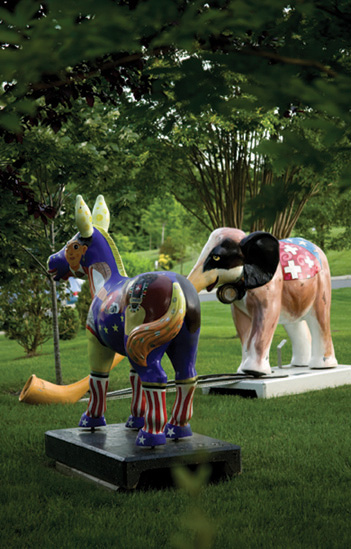
Focal length 85mm; ISO 100; aperture f/5.6; shutter speed 1/50; May 6:30 p.m.
The Woodley neighborhood in springtime is an absolute plethora of color. This scene on Klingle Road near the Klingle Valley Park stood out as unrivaled, however, not for its profusion of blooms, but for the alternating arrangement of pink and white between the houses and blossoms. The anonymous gardeners and house painters worked in perfect synchronization to provide the passerby a visual trick and treat. I stood across the street from the scene and composed carefully both to crop out street wires and poles and to convey this pattern to its full effect. I set my aperture as small as possible given the dim light of an overcast morning in order to reap the most depth of focus and still be able to handhold with security. This shot looks best with as much of the scene in focus as possible.
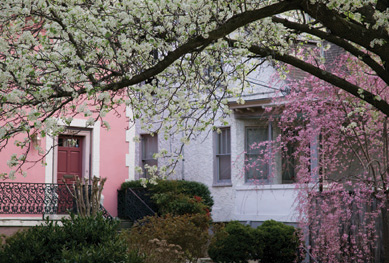
Focal length 105mm; ISO 100; aperture f/7.1; shutter speed 1/50; April 7:11 a.m.
Woodley Park is served by the Woodley Park-Zoo Metro station on the Red Line. It lies on either side of Connecticut Avenue to the north of the station. Most of the single-family residences lie to the west of Connecticut Avenue. In this vicinity, you will find guesthouses offering a peaceful environment to act as your base of exploration of the District.
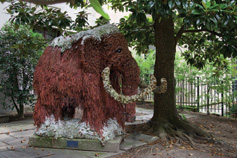
A “Party animal” of a different texture.
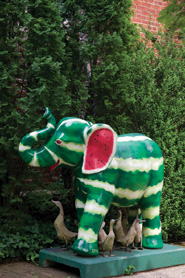
Another “Party animal.”

Springtime color in Woodley Park.
FBI statistics indicate that Washington, DC is a city like any other when it comes to the occurrence of crime. This may cause you to feel that the local police have their hands full with traditional police activities. However, rarely does a metropolitan police force conduct itself with as much helpfulness to the law-abiding citizen as does that of DC, and therein lies opportunity for the photographer.
The Metropolitan Police Department was established in 1861 with around 150 constables. The unit has grown to today’s complement of more than 4,500 members (officers and civilians) with a budget of more than $500 million. The first three women officers were sworn in in 1918, and nearly one-fourth of the current force is composed of women officers. History was made when Cathy L. Lanier was named the first female chief of police in 2007. Mirroring the makeup of the resident population that it serves, about 70 percent of the force is black, Hispanic, or Asian.
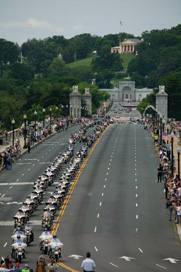
A police escort across the Arlington Bridge.
Areas such as the National Mall and Memorials and the President’s, Rock Creek, and Anacostia Parks fall under the jurisdiction of the U.S. Park Police, who, in their turn, have been charged with protection of the National Parks for more than 200 years.
The compact and diverse nature of the northwest quadrant of DC and the activities that take place there require that police officers utilize a variety of means of transport, leading to a wide array of interesting photographic possibilities.
There is nothing like a shot of police vehicles from foreground to infinity to elicit a feeling of security. No infractions were going to occur here, that is for sure! I saw this shot from quite a distance, and I knew that a long line of such repetitious shapes would make a striking picture. I positioned myself at the beginning of the line and stretched up on my toes to see as much of the tops of the motorcycles as I could and to capture the feeling of infinity.
I was very careful not to include too much extraneous background at the top of the frame—this would have ruined the effect of the Harleys going on forever. I shot with both a small f-stop and a medium focal length in order to have deep focus, and I composed with the path of black leather seats in the middle of the composition.
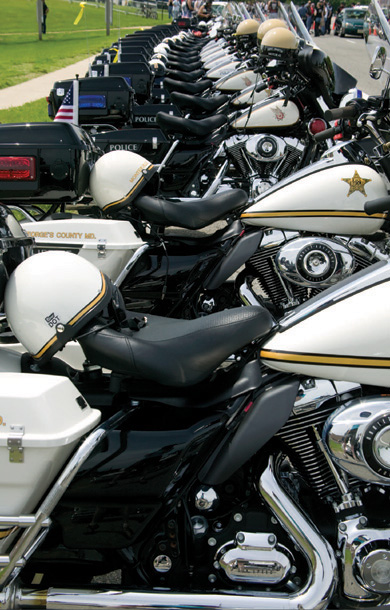
Focal length 53mm; ISO 100; aperture f/11; shutter speed 1/60; May 10:44 a.m.
This is one of those photographs that really gives you a feeling of synchronicity and that, possibly, the subjects in the picture had conversed beforehand and worked out their lines and placement on the set, with each subject gazing in a different direction and seemingly unaware of one another. I sensed that I had a striking picture, as the light filtered through the trees in a lovely way and the policeman on his horse made such a commanding figure. It was not until I downloaded my files, however, that I noticed how each figure in the frame looked frozen in time. Even the cyclist, who was obviously riding forward, seems to be standing motionless. Learn to trust your instincts, and when you do feel there is a picture in front of you, there probably is!
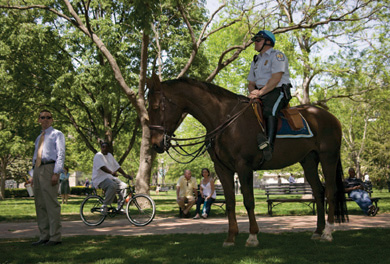
Focal length 47mm; ISO 100; aperture f/5; shutter speed 1/200; April 12:29 p.m.
The Washington, DC police force is remarkable for the cheerfulness and approachability that their officers exhibit—particularly so for a major city force. You will find them fulfilling their duties throughout the District, but most of the photographic opportunity is to be found in the northwest quadrant.
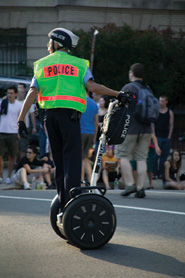
An alternative means of transportation.
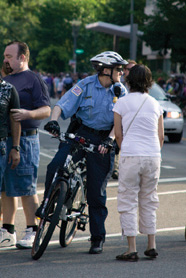
A more traditional two-wheeled transport.
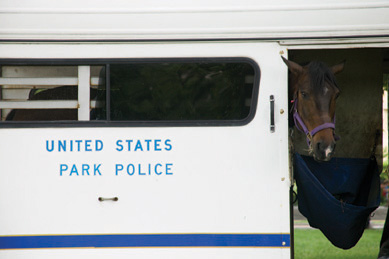
One half of a police duo resting up.


